W i t n e s s
S e p t e m b e r 08, 2 0 1 6 - N o v e m b e r, 0 6, 2 0 1 6
I can feel myself under the gaze of someone whose eyes I do not see, nor even discern. All that is necessary is for something to signify to me that there may be others there.
Lacan
The first written use of the word Witness is found during the early medieval period. A time when literacy began to spread widely, allowing us to break boundaries of communication. As populations and cities mushroomed populations felt the need to become ever more watchful and observant. Into this world Witness was born.
Originally the word Witness meant knowledge, in the sense that you must see, observe or know by personal presence. Over time it became understood as a means of establishing identity and thus the notion of the eye-witness was established: one who testifies to what they have perceived through their senses; tasting, touching, hearing...and seeing. The seeing, witnessing machine, is something that has been imagined and alluded to for centuries. This exhibition contemplates the seeing machine.
There are five works of art in this exhibition. Each sets up an interplay between the perceiving machine, the world that is perceived by the machine and we, who are both perceiving + perceived bodies. A symbiotic relationship is formed between organic and non-organic systems. There are many ways of seeing. One process of controlled watching is surveillance; a monitoring of behavior for the purposes of influence, discipline, protection or control. It has been said that surveillance is as old as civilization itself. In this exhibition we encounter deeply coded, multi-layered processes of seeing, recognition and surveillance.
Machine vision can often outperform humans. Like humans, machines can distinguish light from dark. They form visual images. They understand their surroundings and have knowledge of the world. They follow our movements, predict our behavior, captivate us and bond with us. Perhaps more importantly we bond and enable them. This exhibition allows us to imagine futures and recall why sight developed.
Lacan
The first written use of the word Witness is found during the early medieval period. A time when literacy began to spread widely, allowing us to break boundaries of communication. As populations and cities mushroomed populations felt the need to become ever more watchful and observant. Into this world Witness was born.
Originally the word Witness meant knowledge, in the sense that you must see, observe or know by personal presence. Over time it became understood as a means of establishing identity and thus the notion of the eye-witness was established: one who testifies to what they have perceived through their senses; tasting, touching, hearing...and seeing. The seeing, witnessing machine, is something that has been imagined and alluded to for centuries. This exhibition contemplates the seeing machine.
There are five works of art in this exhibition. Each sets up an interplay between the perceiving machine, the world that is perceived by the machine and we, who are both perceiving + perceived bodies. A symbiotic relationship is formed between organic and non-organic systems. There are many ways of seeing. One process of controlled watching is surveillance; a monitoring of behavior for the purposes of influence, discipline, protection or control. It has been said that surveillance is as old as civilization itself. In this exhibition we encounter deeply coded, multi-layered processes of seeing, recognition and surveillance.
Curation + Design: Sarah Joyce + Gordon Duggan
Machine vision can often outperform humans. Like humans, machines can distinguish light from dark. They form visual images. They understand their surroundings and have knowledge of the world. They follow our movements, predict our behavior, captivate us and bond with us. Perhaps more importantly we bond and enable them. This exhibition allows us to imagine futures and recall why sight developed.
Curation + Design: Sarah Joyce + Gordon Duggan
Adam Basanta
A Truly Magical Moment
Two i-phones face each other on angled selfie sticks (a stick designed to promote a narcissistic gaze). A familiar dial-up tone plays and the Apple Video Chat Platform Face Time kicks in. A human face appears on one screen. Another dial tone ; another face. This mutual gaze occurs across an unfathomable and intimate distance, now a performance space. A truly magical Moment by Adam Basanta creates an absurd yet oddly familiar situation using familiar and aesthetically beautiful telecommunication tools. The work completes a few dizzying optical circuits. We witness the gaze. It is a recursive performance of seeing and being seen. It is a personal moment, a shared moment; voyeurism, exhibitionism, many times over.
Image
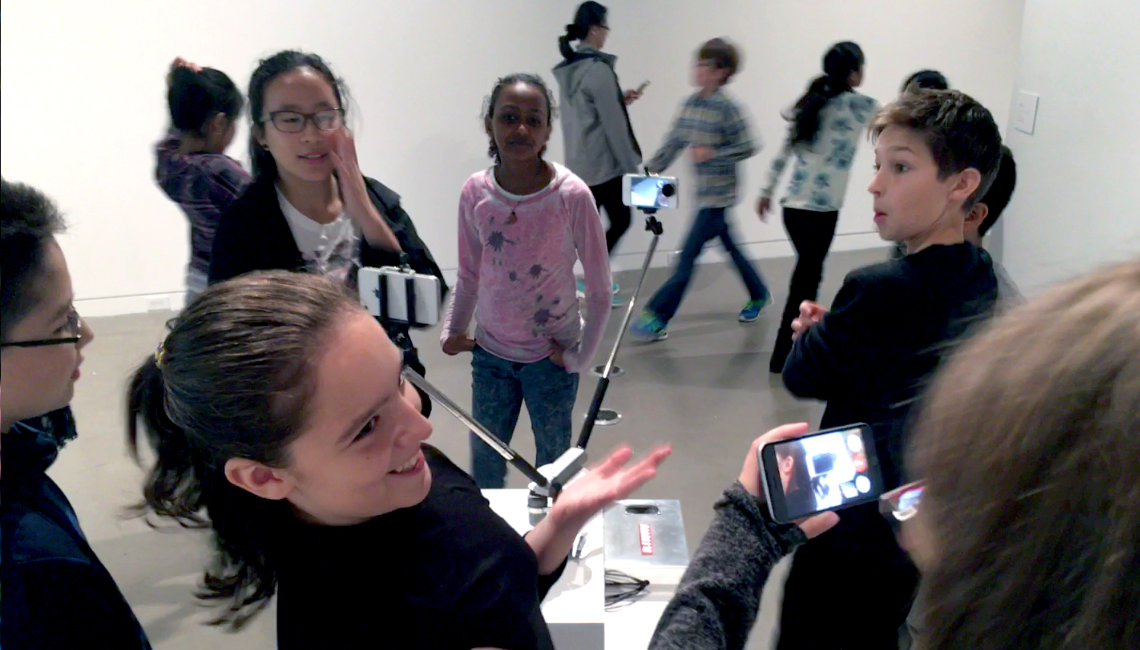
Credits
Adam Basanta
A Truly Magical Moment
2016
2 cell phones, 2 cell phone sticks, electronics, speaker, rotating motor
A Truly Magical Moment
2016
2 cell phones, 2 cell phone sticks, electronics, speaker, rotating motor
Biography
Adam Basanta (b. 1985) is a Montreal-based sound artist, composer, and performer of experimental music. His work traverses sound installations, experimental electronic and chamber music composition, site-specific interventions, and laptop performance. Across disciplines and media, he interrogates intersections between conceptual and sensorial dimensions of listening, the materiality of technological apparatus, and the instabilities of instrumentality.
His sound and audiovisual installations have been presented in North America and Europe in galleries and institutions including Carroll/Fletcher Gallery (London), Serralves Museum (POR), Edith-Russ-Haus fur Mediakunst (GER), Vitra Design Museum (GER), Laboral (ESP), Gallery B-312 (Montreal), Fonderie Darling (Montreal), Titanik Gallery (FIN), and The Center for Contemporary Arts Santa Fe (USA), and have been awarded in the Prix Ars Electronica 2013 and the 2014 Edith-Russ-Haus Awards for Emerging Media Artists.
His experimental concert music has been presented worldwide, including appearances in the MATA Festival (NY), Gaudeamus Musicweek (NL), CTM Festival (GER), Akousma Festival (CAN), and Mutek Festival (CAN), and have been awarded multiple national and international prizes, including Metamorphoses 2010 (Belgium) and the Grand Prize in the SOCAN Foundation Awards for Young Composers (Canada). Recently, his music has been released on Kohlenstoff Records (Montreal), Cassauna (USA), and Farmacia901 (Italy).
Adam holds a BFA in composition from Simon Fraser University (Vancouver, BC) and an interdisciplinary MA in composition and sound art installation at Concordia University (Montreal, QC).
Rafael Lozano-Hemmer
Surface Tension
The eye opens as you enter the room; follows your every move with what could be Orwellian intent. Surface Tension by Rafael Lozano-Hemmer will probably elicit some level of anxiety in the visitor, trapped under its irresistible gaze. The artist has acknowledged the predatory, watchful movements of this eye, at the same time questioning the horrible truth; does it really see you, does it care? It looks like a biologic eye: it behaves like a machine. It sees: it is blind. The work is a paradox. Created at the time of the first Gulf War the work references the use of surveillance and drone technologies and the role and accuracies of a militaristic gaze.
Image
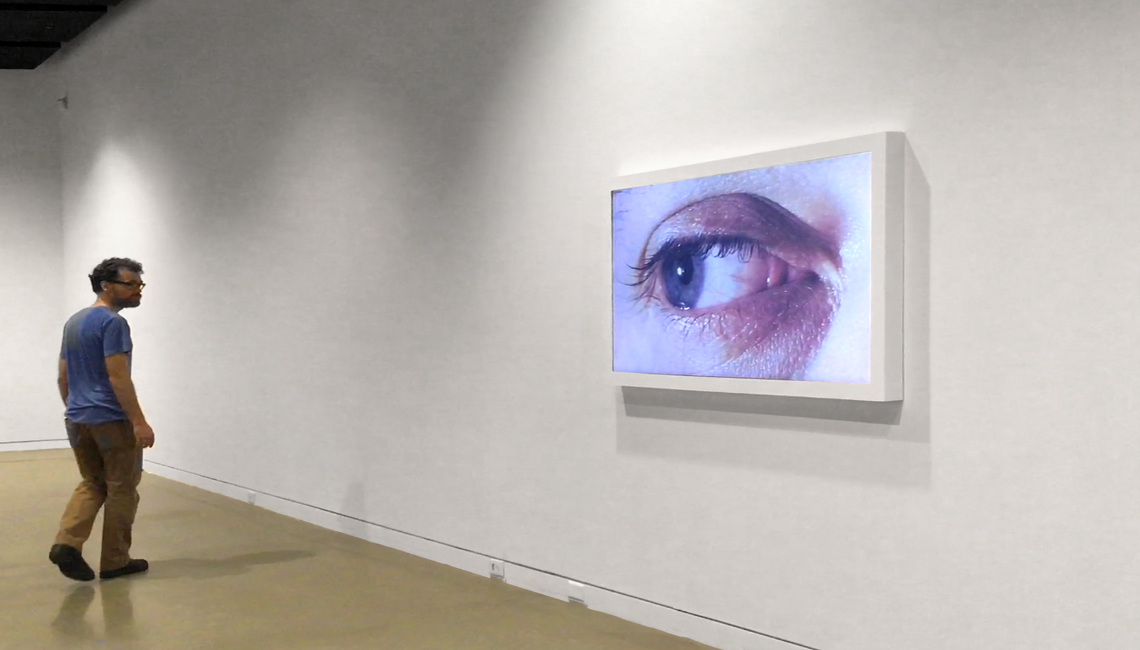
Credits
Rafael Lozano-Hemmer
Surface Tension
1992 (2001)
Infra Red Light, Infra Red Camera, Mac Mini, 65" LCD Monitor
Surface Tension
1992 (2001)
Infra Red Light, Infra Red Camera, Mac Mini, 65" LCD Monitor
Biography
Rafael Lozano-Hemmer (B. 1967 Mexico City) is an electronic artist who works with ideas from architecture, technological theatre, and performance. He has a BS in Physical Chemistry from Concordia University in Montreal. He lives and works in Montreal and Madrid.
The son of Mexico City nightclub owners, Lozano-Hemmer was drawn to science. Initially he worked in a molecular recognition lab in Montreal and published his research in Chemistry journals. Though he did not pursue the sciences as a direct career, it has influenced his work in many ways, providing conceptual inspiration and practical approaches to create his work. Lozano-Hemmer’s work can be considered a blend of interactive and performance art, using both large and small scale, indoor and outdoor settings, and a wide variety of audiovisual technologies.
Lozano-Hemmer is best known for creating and presenting theatrical interactive installations in public spaces across Europe, Asia and America. Using robotics, real-time computer graphics, film projections, positional sound, internet links, cell phone interfaces, video and ultrasonic sensors, LED screens and other devices, his installations seek to interrupt the increasingly homogenized urban condition by providing critical platforms for participation.. Lozano-Hemmer’s smaller-scaled sculptural and video installations explore themes of perception, deception and surveillance. In 2007, he became the first artist to officially represent Mexico at the Venice Biennale. His work is collected worldwide, in the Tate and Museum of Modern Art, NY.
France Cadet
Do Robotic Cats Dream of Electric Fish?
Do robotic cats dream of electric fish? The hacked robotic cat by France Cadet gazes at a little fish on a big screen: the lovable and commodified Nemo. The cat has been altered by the artist to respond to the fish on the screen. The work references Philip K. DIck's 1968, sci-fi novel, 'Do Androids Dream of Electric Sheep' in which the empathic gaze places a significant role in defining what is human. Much of Cadet’s work questions the boundaries between humans and animals and how these boundaries affect us. Inferring that this robot cat can see tells us this is an entity that is fully alive and ‘real’. Does the cat see and desire of its own free will? The act of watching and desiring becomes a critique on...the act of watching and desiring. The fish exists only on the big screen. The cat will never capture what it desires. Perhaps that is the point.
Image
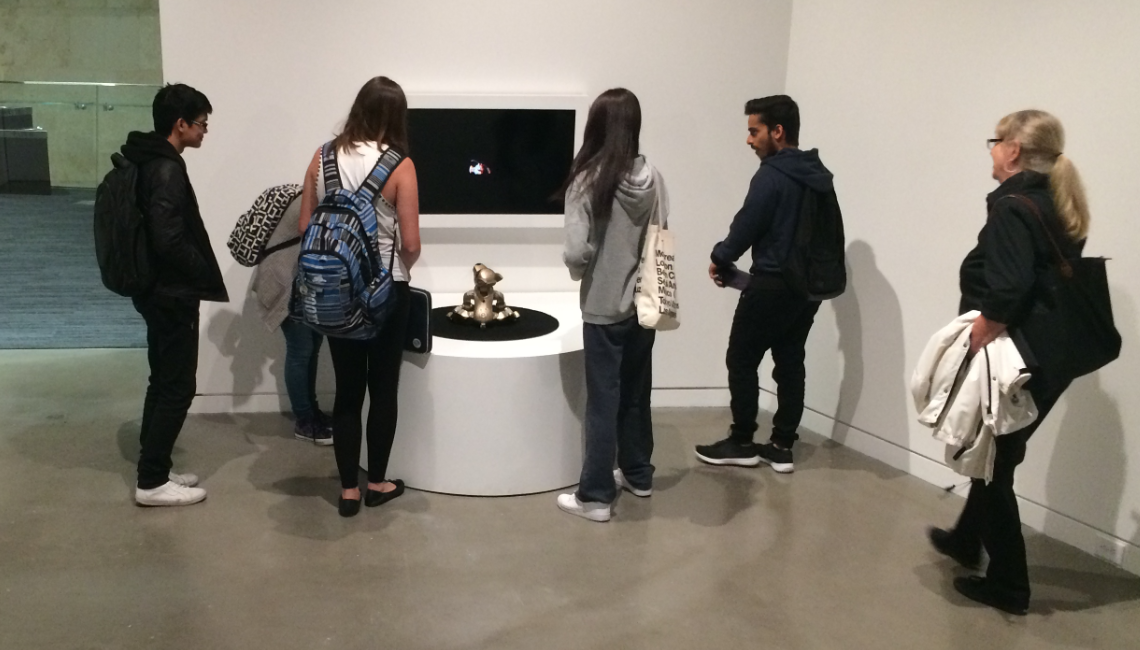
Credits
Do Robotic Cats Dream of Electric Fish?
2007
Autoplay/Autorun digital loop – 2 min.
Installation Dimensions 7’(H) x30”(D) x 36”
Robotic Cat (altered), Plinth, Flat Screen, Digital Files, Plastic, Batteries, Rubber, LEDs, Circuit boards and chips
2007
Autoplay/Autorun digital loop – 2 min.
Installation Dimensions 7’(H) x30”(D) x 36”
Robotic Cat (altered), Plinth, Flat Screen, Digital Files, Plastic, Batteries, Rubber, LEDs, Circuit boards and chips
Biography
France Cadet, b. 1971, is a French digital and robotics artist whose work raises questions concerning contemporary anxieties on science & biotechnology. She is the head of the robotics lab at Ecole Supérieure d’Art d’Aix-en-Provence, and teaches at the School of the Art Institute of Chicago.
Before turning to art she trained in the sciences. Known for her robotic and bio-oriented multi-media, she has exhibited around the world. Her work is regularly exhibited in international new-media festivals such as Ars Alectronica, Exit, Sonar, Emoção Artificial... likewise in traditional contemporary Art galleries and museums (CAAC in Sevilla, Quadrum Gallery in Lisbon, Pascal Vanhoecke Gallery and Palais de Tokyo in Paris) and Art fairs (ARCO in Madrid, Art Paris and SLICK in Paris…).
She received the 1st Prize of VIDA 6.0, Art & Artificial Life International competition in Madrid, and was mentioned by the Digital Stadium Awards in Tokyo. Her work is in the collection of Museum of Contemporary Art, MEIAC, Spain.
Much of France Cadet’s artworks tackles serious problems in an ironic and ludic way: funny toys, pleasant games, charming pets, cute robots. A large component of her work uses commercial robotic dogs on which she performs surgery, customizing their forms, and reprogramming them with unusual behaviors. These strange new creatures allow her to embody questions concerning contemporary anxieties about biotechnology, animals rights, dangers of cloning, eugenics.
Björn Schülke
Vision Machine #3
Vision Machine #3 is a beautiful nightmare. A delicate, arthropodic work by Bjöern Schülke, characterized by its “lively interior consciousness, it’s complex cycles of communication and movement and the appearance of irrational character traits and distinctive emotional features.” There is an eerie sense of agency - the uncanny feeling that this object has free will, that it is watching us and has understanding. With the exquisite, precision of an arthropod its reflective vision relies on various combinations of compound eyes that swivel to detect their prey. It is a suspicious, vigilant little creature. It sees you. It wants to meet you. Be warned.
Image
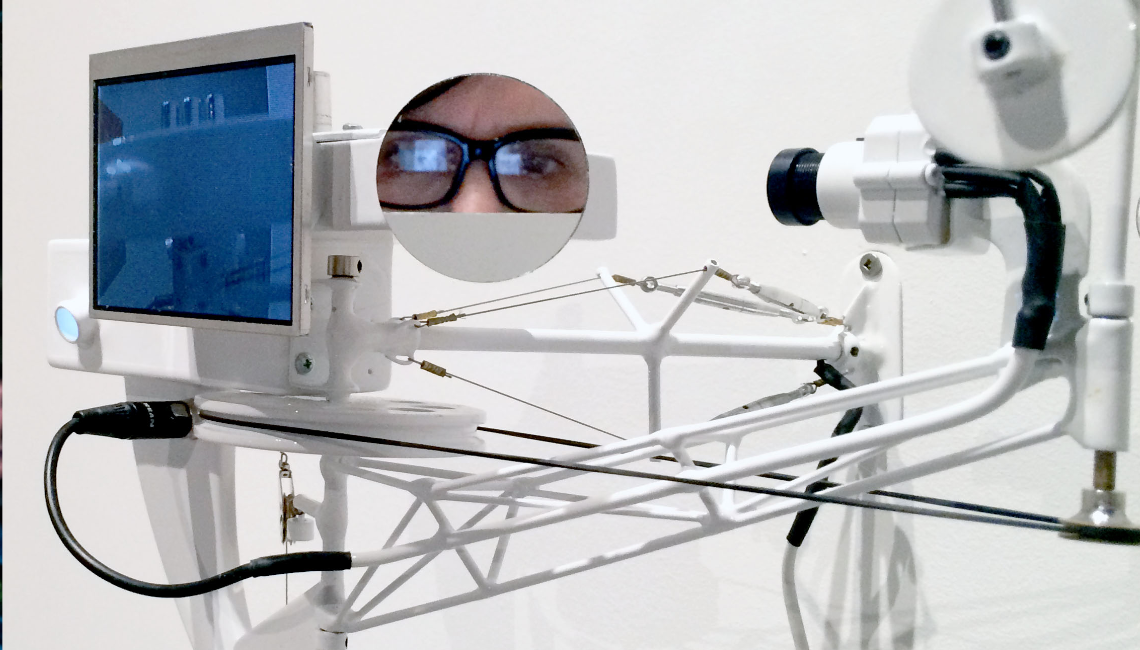
Credits
Björn Schülke
Vision Machine #3
2014
11” x 12” x 15” installed
Wood, brass, steel, camera, screen display, paint, sensor, LED, belt drive, custom electronics, motor, mirrors.
Vision Machine #3
2014
11” x 12” x 15” installed
Wood, brass, steel, camera, screen display, paint, sensor, LED, belt drive, custom electronics, motor, mirrors.
Biography
Björn Schülke pursues a creative style that is equally influenced by modern abstraction and instruments of scientific measurement. The slow deliberate movements in his sculptures spatially consider mass and weight of form. Also influenced by the Dadaist tradition and Jean Tinguely, the theme of an absurd machine is key in Schülke's work. Playfully transforming live spatial energy into active responses, his objects experiment with solar panels, infrared surveillance, and propelled wind power. Many of his larger kinetic sculptures combine elements of surveillance technologies, robotics, interactive video and sound. Schülke's active sculptures question the way in which we interact with modern technology: on entering the installation site, the audience becomes part of the 'system' as the works (some freestanding, others suspended) monitor or react to the human element. Schülke has exhibited around the world.
Stanza
The Agency at the End of CIvilization 2014
A sprawling collection of daisy-chained monitors, watchful orbs and speakers give voice to circulating, machinic narratives. The Agency at the End of Civilization, by British artist Stanza, presents a parallel future-present that combines real-time data with false narratives. In this world we are under constant surveillance; we are watched in precise detail, our movements are interpreted by machines. Yet the interpretation of what we are seeing and hearing becomes increasingly uncertain. The work links real video and information from hundreds of CCTV cameras in the south of England . Aligned to this are millions of car number plates from the UK car number plate recognition system (The Internet of Cars Project). Using predictive software the machine collects what it is seeing in real time, then begins to insert false narratives to create its own version of reality. The work speaks to our control of public space and our trust in technology.
Image
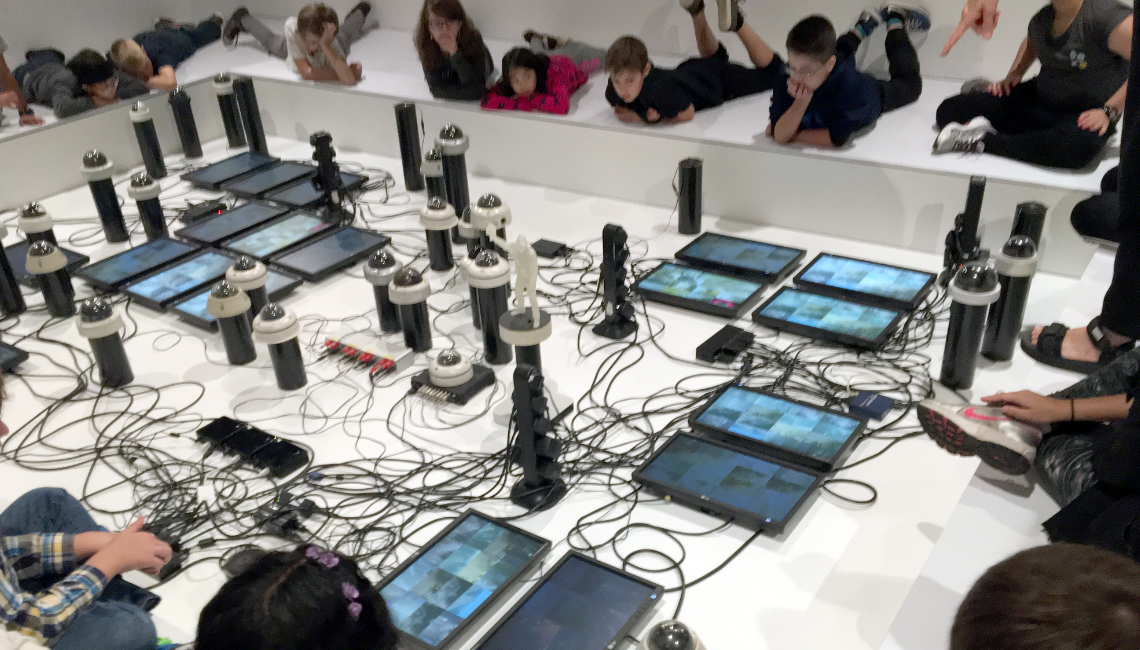
Credits
Stanza
The Agency at the End of CIvilization
2014
22 screens, 36 dome CCTV, 3 NUC PC, 1 Mini Mac,3 VGA splitters, Ethernet hub, 1 Motu sound card, 2 Custom made amps, Loads of tubes and load of power suplies and cables, 1 figure 3d portrait scan, 8 hi end mini speakers.
Size of installation 3 metres by 4.5 metre .(Variable)
The Agency at the End of CIvilization
2014
22 screens, 36 dome CCTV, 3 NUC PC, 1 Mini Mac,3 VGA splitters, Ethernet hub, 1 Motu sound card, 2 Custom made amps, Loads of tubes and load of power suplies and cables, 1 figure 3d portrait scan, 8 hi end mini speakers.
Size of installation 3 metres by 4.5 metre .(Variable)
Biography
Stanza is an internationally recognized, award winning UK digital artist, pioneer in his use of technology in the arts, who boasts a vast and diverse body of work that spans a range of practices, techniques and media: from video and net art works, to interactive installations, responsive environments, generative art and complex digital ecosystems. He started creating and presenting work in the mid-1980s. He uses city images and sounds to reflect upon fractured urbanity, communicating a sense of cultural discontinuity and emotional isolation within a post-industrial urban landscape. Though the thematic strands, aesthetics, and affective impact of Stanza’s work have remained remarkably consistent over the years, dealing with issues such as urbanism, solitude and surveillance culture, his practice has undergone significant shifts: he has moved from creating linear, object-based works such as prints and videos, to (often grand-scale) compositions of (a)live, open-ended, permeable, and unpredictable systems characterized by a state of flux.
His work often deals with cities: urban landscapes and soundscapes, along with their complex social functions and dynamic networks of interconnections, have been central to his artistic practice. Influenced by the Situationist International since the early stages of his career, Stanza undertakes a critique of contemporary urbanism that is not defined primarily by restrictive architectures but by surveillance networks and connective data flows. Stanza’s cybercities and data cities might not directly constitute a terrain of participatory games, but they are playful ‘dérives’ to fragments of urbanism that gesture beyond the functional and into ‘daydreams’ – or urban nightmares.
